Abstract
Physical characteristics of the loaded new developed partially biodegradable LDPE polymeric films (containing sorbit, molasses and chitosan additives) with defects and without have been investigated experimentally by using the method of projection moiré. The first eigenmodes are analysed, graphical results of their investigation are presented. It was determined that the shape of the first vibrations eigenmode and the characteristics of vibrations have changed when the polymeric film had a tear defect. The results obtained could be applied for the determination of characteristics and qualities of new developed LDPE polymeric films.
1. Introduction
In the last decades, the use of polymeric materials has been notably increased. ~49 bn. tones of polymeric materials are manufactured per year in EU countries. ~40 % of this demand is intended for packaging. The waste problem is also important because in most EU countries (including Lithuania) only 50 % of packages are recycled or used for energy recovery. Thus, the growing concern about the harmful impact of discarded polymeric packages leads to the researches and developments of polymeric packaging that could degrade more rapidly in the landfills [1-4].
The other way to solve the polymeric packaging waste disposal is to manufacture combined partially biodegradable blends of raw materials (starch, molasses, chitosan, glycerine and others) and petroleum – based polymeric films. Some researches [5-9] were focused on analysing the thermal, mechanical and biodegradation performance of LDPE films with different type and content of biodegradable material. But these works did not analyse the performance of these new developed polymeric materials during printing or packaging processes.
In the manufacturing cycle of the polymeric packages, flexography printing is important process. When the polymeric film is being transported through the printing sections, it is always tensioned. Also, due the vibrations of printing rollers, beating of bearings and other reason also various mechanical defects may occur in the tensioned polymeric films. Thus, the symmetrical loading during printing is important factor for the quality of the graphical image.
Considering to the works [10-12] projection moiré is a simple method to obtain the eigenmodes that would allow to predict the possible non-qualitative graphical images that could occur during printing process.
The aim of the presented work is to investigate the vibrations, eigenmodes under the symmetrical loading of new developed partially biodegradable LDPE polymeric films having different content and type of additives (sorbit, molasses and chitosan).
2. Experimental details
2.1. Materials
The materials for testing were manufactured at Belarusian National Technical University using an extruder SJM35-400 that screw diameter was 35 mm and length to screw diameter ratio L/D=30:1. Three new developed low density polyethylene (LDPE) polymeric films containing biodegradable additives (with different content 3 and 10 %) such as sorbit, molasses and chitosan and were obtained with the following compositions:
• low density polyethylene + 10 % sorbit (LDPE1);
• low density polyethylene + 3 % molasses (LDPE2);
• low density polyethylene + 3 % chitosan (LDPE3);
2.2. Methods
2.2.1. Projection moiré
To determine the dynamical characteristics of polymeric films with and without defects (tears) for symmetric loading of the tape the special setup for projection moiré experimental investigation was used (Fig. 1).
Fig. 1General view of the setup for projection moiré experimental test: S1 – signal generator; S2 – amplifier; S3 – vibroexciter; S4 – the investigated material; DC – digital camera; PC – personal computer; PR – printer; F – light flux of the digital camera

Fig. 2Cases of symmetrical polymeric film loading in experimental setup: 1 – light source; 2 – raster, 3 – mirror; S1 – signal generator; S2 – amplifier; S3 – vibroexciter; S4 – polymeric film; DC – digital camera; PC – personal computer; PR – printer; P – load
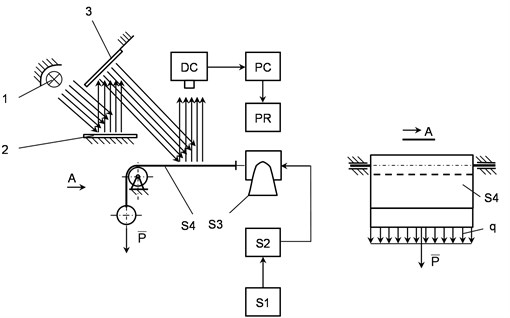
The experimental setup consists of the vibration generator ГЗ-111 (S1), amplifier LV-103 (S2), vibro-exciter VEB Robotron Messelektronik 11076 (S3), investigated polymeric film S4, digital image camera Edmund Optics EO-1312C USB Camera (DC), personal computer PC, ink printer HP Deskjet 920c (PR) and the optical setup of the projection moiré (not indicated in the figure).
In case of symmetric loading of polymeric film the load was distributed symmetrically with respect to the centre line of the tape of the polymeric film by loading both of its sides with the equal load q (see Fig. 2). In the experiment projection moiré was implemented by projecting thin parallel lines of high contrast with the light rays incident to the surface of vibrating polymeric film.
In the process of investigation sinusoidal longitudinal vibrations of the chosen frequency were generated in the setup for analysis of vibrations S3 that generated eigenmodes in the polymeric film.
The ends of the investigated sheet of polymeric film were fastened between pressing tapes. One of the pressing tapes was fastened to the exciter of vibrations while the other pressing tape was loaded symmetrically by the force P of 25.5 N. Vibroexciter S3 was generating longitudinal vibrations of sinusoidal shape of chosen frequency, which excited eigenmodes in the analysed polymeric film. For the visualization of modes of propagating waves the method of projection moiré was used. The grid of thin parallel lines of high contrast of step p was projected at a definite angle to the surface of the investigated material. In this method the eigenmodes were photographed by a digital camera and then processed in the monitor of a personal computer.
In the experimental tests, samples of polymeric film with biodegradable additives and multi-layered material of rectangular geometrical shape (0.2×0.05 m) were produced.
3. Results and discussions
During experimental researches, the partially biodegradable LDPE films have been excited by vibrations of sinusoidal shape in the direction of polymeric film extrusion. The longitudinal vibrations of particular amplitude and by changing excitation frequency have been generated during the experiment. The eigenmodes of vibrations occurred using projection moiré have been recorded. The results obtained are given in Figs. 3-5.
Fig. 3The eigenmodes of partially biodegradable LDPE1 film
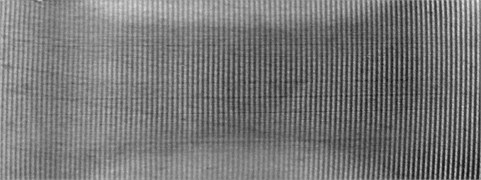
a) First eigenmode (vibration frequency 110 Hz, amplitude 2×10-6 m)
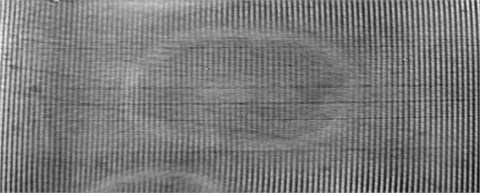
b) Second eigenmode (vibration frequency 162 Hz, amplitude 2×10-6 m)
It was obtained that the first eigenmode of all three partially biodegradable films has been established in the vibrations range 104-136 Hz and the second eigenmode – 148-168 Hz range of vibrations. Further increase of the excitation frequency do not established any eigenmodes of higher order.
The manufacture of polymers is quite complicated, during the technological process of manufacturing many defects may occur. Thus, the partially biodegradable LDPE films with defects have been analysed during the experimental researches. The results obtained are shown in Figs. 6-8.
In case of tear defect in the analysed LDPE films only the one eigenmode of vibrations has been established. The eigenmode of LDPE1 film has been established in the higher range of vibrations (140-164 Hz) and of LDPE2 and LDPE3 films in the lower range of vibrations (LDPE2 – 126-140 Hz, LDPE3 – 122-134 Hz). Also in all three partially biodegradable polymeric films the shape of the established eigenmode was of different configurations. Thus, the method of projection moiré could be applied for the analysis of uneven structure of partially biodegradable polymeric film.
Fig. 4The eigenmodes of partially biodegradable LDPE2 film
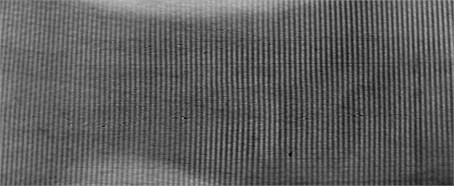
a) First eigenmode (vibration frequency 116 Hz, amplitude 2×10-6 m)
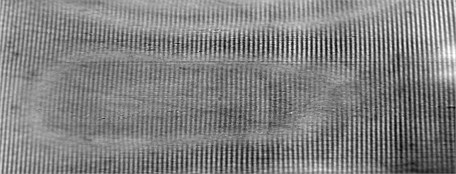
b) Second eigenmode (vibration frequency 160 Hz, amplitude 2×10-6 m)
Fig. 5The eigenmodes of partially biodegradable LDPE3 film
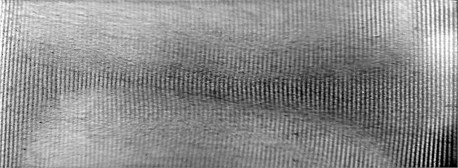
a) First eigenmode (vibration frequency 120 Hz, amplitude 2×10-6 m)
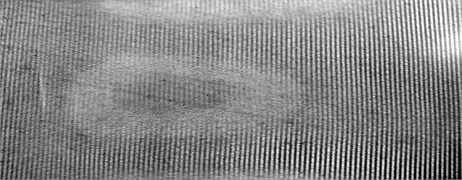
b) Second eigenmode (vibration frequency 158 Hz, amplitude 2×10-6 m)
Fig. 6The first eigenmode of partially biodegradable LDPE1 film (with tear defect) (vibration frequency 156 Hz, amplitude 2×10-6m); 1 – tear defect
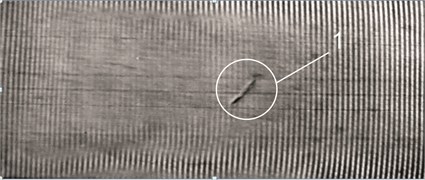
Fig. 7The first eigenmode of partially biodegradable LDPE2 film (with tear defect) (vibration frequency 132 Hz, amplitude 2×10-6m); 1 – tear defect
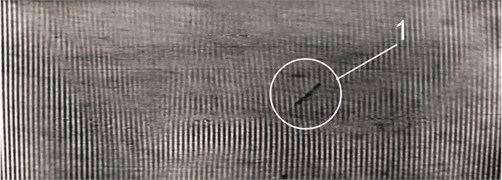
Fig. 8The first eigenmode of partially biodegradable LDPE3 film (with tear defect) (vibration frequency 128 Hz, amplitude 2×10-6m); 1 – tear defect
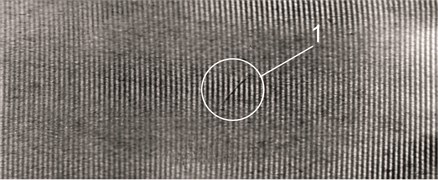
4. Conclusions
Three new developed partially biodegradable LDPE polymeric films containing different type (molasses, chitosan and sorbit) and content of additives (10 and 3 %) was evaluated for identification of defects using a method of projection moiré. It was determined that the shape of the first vibrations eigenmode and the characteristics of vibrations have changed when the polymeric film has a tear defect comparing with the first eigenmode of qualitative polymeric films. Also, when the LDPE films have a tear defect only the first eigenmode has been established, meanwhile for the qualitative polymeric films the first and second eigenmodes have been established.
The range of vibrations frequency at which the eigenmodes have been established is higher for partially biodegradable LDPE films with defects than without defects. For LDPE1 (additive sorbit and with tear defect) the range of vibrations frequency is 156 Hz, without defects – 110 Hz, for LDPE2 (additive molasses and with tear defect) is 132 Hz, without defects – 116 Hz, for LDPE3 (additive chitosan and with tear defect) – 128 Hz, without defect – 120 Hz.
The results obtained could be used for further researches of non-destructive identification of these new developed partially biodegradable LDPE films by applying them for packaging purposes.
References
-
Peelman N., Ragaert P., De Meulenaer B., et al. Application of bioplastics for food packaging. Trends in Food Science and Technology, Vol. 32, Issue 4, 2013, p. 128-141.
-
Langley J., Turner N., Yoxall A. Attributes of packaging and influences on waste. Packaging Technology and Science, Vol. 24, Issue 3, 2011, p. 161-175.
-
Avella M., De Vlieger J. J., Errico M. E., Fischer S., Vacca P., Volpe M. G. Biodegradable starch/clay nanocomposite films for food packaging applications. Food Chemistry, Vol. 93, Issue 3, 2005, p. 467-474.
-
Jamshidian M., Tehrany E. A., Imran M., Jacquot M., Desobry S. Poly-lactic acid: production, applications, nanocomposites and release studies. Comprehensive Reviews in Food Science and Food Safety, Vol. 9, Issue 5, 2010, p. 552-571.
-
Rodriguez Gonzalez F. J., Ramsay B. A., Favis B. D. High performance LDPE/thermoplastic starch blends: a sustainable alternative to pure polyethylene. Polymer, Vol. 44, Issue 5, 2003, p. 1517-1526.
-
Nakamura E. M., Cordi L., Almeida G. S. G., Duran N., Mei L. H. I. Study and development of LDPE/starch partially biodegradable compounds. Journal of Materials Processing Technology, Vols. 162-163, 2005, p. 236-241.
-
Thakore I. M., Desai S., Sarawade B. D., Devi S. Study on biodegradability, morphology and thermomechanical properties of LDPE/modified starch blends. European Polymer Journal, Vol. 37, Issue 1, 2001, p. 151-160.
-
Garg S., Jana Kumar A. Studies on the properties and characteristics of starch-LDPE blend films using cross-linked, glycerol modified, cross-linked and glycerol modified starch. European Polymer Journal, Vol. 43, Issue 9, 2007, p. 3976-3987.
-
Matzinos P., Bikiaris D., Kokkou S., Panayiotou C. Processing and characterization of LDPE/starch products. Journal of Applied Polymer Science, Vol. 79, Issue 14, 2001, p. 2548-2557.
-
Pourvais Y., Asgari P., Moradi A. R., Rahmani O. Experimental and finite element analysis of higher order behaviour of sandwich beams using digital projection moire. Polymer Testing, Vol. 38, Issue 6, 2014, p. 7-17.
-
Ragulskis M., Maskeliūnas R., Saunorienė L. Identification of in-plane vibrations using time average stochastic moire. Experimental Technique, Vol. 29, 2005, p. 41-45.
-
Van Paepegem W., Shulev A., Moentjens A., Harizanova J., Degrieck J., Sainov V. Use of projection moire for measuring the instantaneous out-of-plane deflections of composite plates subject to bird strike. Optics and Lasers in Engineering, Vol. 46, Issue 7, 2008, p. 527-534.
About this article
This work was prepared in the frame of project “Creation of Biodegradable Polymer Packing Materials and Research of Physical and Mechanical Properties” within the Lithuanian – Belarus Partnership Programme for Bilateral Cooperation in the Field of Science and Technologies (Agreement No. TAP LB-02/2015, Project duration: 2015-2016, Project leaders: Prof. E. Kibirkštis and Prof. V. Kuzmich). Also, this work is supported by JSC “Aurika” (Support Agreement No. SV8-0067 2015.10.12).
